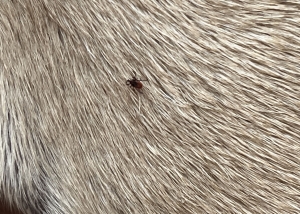Tick-Borne Diseases: Types, Symptoms, and Prevention
Ticks are already here – Why the sudden increase?
As the warmer weather arrives, so do the ticks. However, the past few years have seen a dramatic increase in tick populations, leaving many pet owners wondering why. The answer lies in the increase of deer and rodents, which serve as a primary food source for ticks. As these animals travel in and out of wooded and grassy areas, they bring a larger tick population into more heavily populated areas. The more these ticks feed, the more they reproduce, leading to a greater population.
Tick-borne Diseases and Prevention
Ticks can transmit a number of harmful diseases to both pets and humans. It’s crucial for pet owners to be aware of the signs and symptoms of tick-borne diseases and take preventative measures to protect their pets. Traditional pesticide flea and tick preventatives have become less effective due to ticks becoming increasingly resistant. As a result, many pet parents are turning to alternative options to keep their pets safe.
It is important to note that multiple brands or types of chemical preventatives should NEVER be used in conjunction with one another. Severe reactions due to overdoses of chemicals or interactions between chemicals can cause harm to you or your pet. Always follow package directions and advice from your veterinarian in regards to these products.
Some research shows that ticks need to feed between 36-48 hours before they can transmit disease; however, there have also been a few cases of exposure in a shorter time frame.

Types of Tick-Borne Disease
Lyme Disease
Tick-borne diseases, also known as vector-borne diseases, are infections transmitted through the bite of an infected arthropod, such as mosquitoes or ticks. In pets, Lyme Disease is one of the most commonly talked about tick-borne diseases. This infection is transmitted through the bite of Deer Ticks or Western Black-Legged Ticks and can lead to lameness in pets.
Detecting tick-borne diseases in pets can be challenging, as symptoms may vary. Unlike in humans, pets won’t display a bullseye rash near the site of a tick bite. Instead, pet owners should watch out for signs such as lameness in the back legs, fatigue, loss of appetite, reluctance to move, and depression. If your pet is exhibiting any abnormal behavior or unusual signs, it’s essential to consult your veterinarian.
Ehrlichiosis
Ehrlichiosis is a zoonotic disease transmitted by the Brown Dog Tick or the Lone Star Tick. Like Lyme Disease, the signs of Ehrlichiosis may not be immediately evident, and different types of infection can produce various signs and symptoms. This infection affects blood cells and can impact bone marrow function, production of blood cells, and immune function. Common signs of Ehrlichiosis in pets include depression, fatigue, loss of appetite, eye and nasal discharge, nose bleeds, bruising of the oral mucosa and abdomen, lameness, and joint pain.
Pet owners must remain alert for any abnormal behavior or unusual signs in their pets. If your pet is exhibiting any signs that don’t seem to make sense or behaving abnormally, it’s important to visit your veterinarian. The earlier the detection, the better the chances of recovery.
Anaplasmosis
Canine Anaplasmosis infection can occur in two different types, each transmitted by a different tick species. The first type is an infection of the white blood cells that is transmitted by the Deer tick and the Western Black-Legged tick, which can also transmit Lyme Disease. Therefore, the risk of co-infection with Anaplasmosis is high for dogs infected with Lyme disease. The common signs of this type of Anaplasmosis infection include loss of appetite, lethargy, lameness, and neurological pain, particularly in the neck.
The second type of Anaplasmosis infection is an infection of the blood platelets that eventually leads to clotting disorders. This type is transmitted by the Brown Dog Tick, and the signs include bruising in the mouth and/or abdomen, and nosebleeds.
Pet owners should stay vigilant and take their dogs to the veterinarian if they display any abnormal behavior or symptoms. It’s essential to diagnose and treat Anaplasmosis infection early to improve the chances of recovery.
Rocky Mountain Spotted Fever
Rocky Mountain Spotted Fever is another zoonotic disease found throughout the US & Canada. Many people here in New England think their family or pets are not susceptible to RMSF until they hear of a local infection. RMSF is transmitted by the American Dog Tick or the Long Star Tick. If not treated early, this infection can result in death.
In regards to dogs, RMSF appears suddenly with severe illness that lasts approximately two weeks. Unlike people, dogs do not develop a rash once infected. Common signs include arthritis (stiffness when walking), neurological abnormalities, general malaise, and loss of appetite.
Hepatozoonosis
Hepatozoonosis can come in two forms: Hepatozoon americanum, carried by the Gulf Coast Tick and Hepatozoon canis, carried by the Brown Dog Tick. Unlike the other diseases discussed, these two forms are transmitted by a dog ingesting an infected tick.
Signs of Hepatozoon canis infection may be non-existent or subtle, but can include loss of appetite, weight loss, and lethargy.
Signs of Hepatozoon americanum can be more severe and potentially fatal. This form affects muscle cells, which can be painful and can result in severe signs, including fever, pain, muscle atrophy (loss of muscle mass), weight loss, and loss of appetite.
Babesiosis
Babesiosis, transmitted by the Brown Dog Tick, affects red blood cells, causing anemia, which causes the immune system to go into overdrive to fight off infection. As a result, the dog generally becomes weak. Other signs include lameness, weakness, lethargy, loss of appetite, and weight loss
Babesiosis can also be transmitted if an infected dog bites another dog.
Prevention
Parasites typically target hosts that are not in optimal health. For instance, healthy humans, cats, and dogs generally do not get sick as often. However, individuals who don’t take good care of themselves, eat poor diets, and have health conditions such as diabetes, kidney disease, and obesity are more susceptible to illness.
Maintaining a nutritious diet is the cornerstone of preventing ticks and tick-borne diseases. This doesn’t mean buying the most expensive pet food available with the expectation that your pet will be completely protected from ticks. Instead, it means making informed and healthy choices for your pet.
These pet food choices include:
- Looking for whole meat as a first ingredient
- Eliminating fillers such as corn, wheat & soy
- Eliminating chemical preservatives & dyes
- Eliminating sugary & starchy snacks
- Hydrating any dry kibble diets with bone broth, goat milk, or water
- Adding fresh meat, vegetables & fruit to your dog’s dish
Supplements to Boost Tick Defense
It is important to note that every animal is different and therefore, each product has the potential to impact each animal differently.
Garlic
A simple preventative you can start right away is to add a pinch of granulated garlic to your pet’s food. Fresh garlic is even more effective – chop/crush up a ¼ clove for a small dog, ½ clove for a medium-large dog and a whole clove for dogs over 100lbs.
The myth that garlic is dangerous in any amount comes from the fact that onions can cause anemia, which is true. However, garlic is only toxic to dogs in large amounts, which is pretty much the rule of thumb for almost anything. While garlic and onion are related, they do not carry the same risks.
Garlic is a very effective preventive for tick bites. However, most pet owners want an immediate solution, and garlic can take 2-3 weeks to build up in a dog’s system. Our best advice is to begin using garlic daily for 2-3 weeks and then use it 3 times a week for maintenance.
Apple Cider Vinegar
Apple cider vinegar adds acidity to your dog’s blood, making it less appealing to ticks and fleas.
Cedar Oil & Other Essential Oils
Essential oils are great customizable options that can help repel fleas, ticks & mosquitoes for your pets and your family. One of our ‘house favorites’ is by Earth Animal, which offers a full line of pest control for your pets formulated by Dr. Bob Goldstein. This is an all-natural, safe & comprehensive preventative and treatment line with an herbal collar, natural spot-on, shampoo, liquid drop, internal powder and spray. In particular, Earth Animal pet sprays can replace all chemical flea & tick options, making your pet and home chemical-free. These products are safe for children and young pets, kill the entire life cycle of an infestation, and are made from 100% natural, human-grade ingredients.
Diatomaceous Earth (DE)
Diatomaceous Earth is one of my favorite flea and tick preventatives. I make a point to visit our local pool store every year and stock up on several buckets of DE, which I then spread all over my lawn. DE is made from the fossilized remains of tiny aquatic organisms called diatoms. When fleas and ticks crawl through the white dust of DE, the tiny particles damage their exoskeletons and cause them to dehydrate and die. Thanks to DE, I’ve had great success in keeping fleas, ticks, and mosquitoes away from my pets and out of my home.
Conclusion
Stop in and speak with one of our awesome staff members with any questions.
Several of our customers look for additional products to use along with spot-ons, flea collars, and oral preventatives. It’s important to note that the following methods have no known side effects when used alongside prescription products. However, we strongly advise consulting with your veterinarian before combining these methods with prescription medications for your pet.
*This article is for informational purposes only. It is not meant to provide medical advice or replace the advice of a qualified veterinarian.
About NorthPoint Pets
NorthPoint Pets & Co. provides pet parents and pets with premium food and unbiased and honest information regarding the care, feeding, and behavioral drivers of dogs and cats. Our team of experts brings years of experience and education, as well as personality, perspective, and passion to everything we do. Visit the NorthPoint Pets & Co. store in Cheshire, CT – we’re open seven days a week and can’t wait to meet you and your pets!






